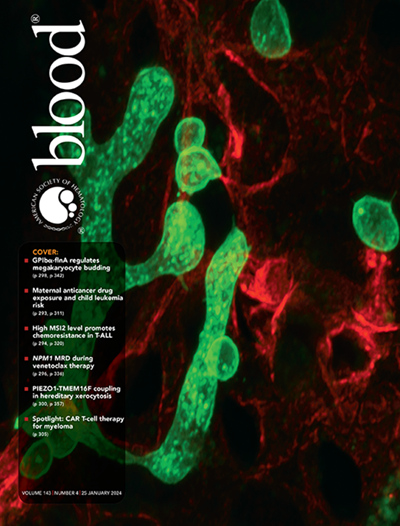Association of Epstein-Barr virus genomic alterations with human pathologies.
IF 21
1区 医学
Q1 HEMATOLOGY
引用次数: 0
Abstract
Epstein-Barr virus (EBV) infects over 90% of humans and is associated with both hematological and epithelial malignancies. Here, we analyzed 990 EBV genomes (319 newly sequenced and 671 from public databases) from patients with various diseases to comprehensively characterize genomic variations, including single nucleotide variations (SNVs) and structural variations (SVs). While most SNVs were a result of conservative evolution and reflected the geographical origins of the viral genomes, we identified several convergent SNV hotspots within the central homology domain of EBNA3B, the transactivation domain of EBNA2, and the second transmembrane domain of LMP1. These convergent SNVs appear to fine-tune viral protein functionality and immunogenicity. SVs, particularly large deletions, were frequently observed in chronic active EBV disease (28%), EBV-positive diffuse large B-cell lymphoma (48%), extranodal NK/T-cell lymphoma (41%), and Burkitt lymphoma (25%), but were less common in infectious mononucleosis (11%), post-transplant lymphoproliferative disorder (7%), and epithelial malignancies (5%). In hematological malignancies, deletions often targeted viral microRNA clusters, potentially promoting viral reactivation and lymphomagenesis. Non-deletion SVs, such as inversions, were also prevalent, with several inversions disrupting the C promoter to suppress latent gene expression, thereby maintaining viral dormancy. Furthermore, recurrent EBNA3B deletions suggested that this viral transcription factor functions as a tumor suppressor. EBNA3B knockout experiments in vitro revealed downregulation of human tumor suppressors, including PTEN and RB1, which could explain the enhanced lymphomagenesis observed in EBNA3B-deficient lymphoblastoid cell line xenografts. Our findings highlight both disease-specific and general contributions of EBV genomic alterations to human cancers, particularly in hematological malignancies.爱泼斯坦-巴尔病毒基因组改变与人类病理的关系
eb病毒(EBV)感染超过90%的人类,与血液学和上皮恶性肿瘤有关。本文分析了来自不同疾病患者的990个EBV基因组(其中319个是新测序的,671个来自公共数据库),以全面表征基因组变异,包括单核苷酸变异(snv)和结构变异(SVs)。虽然大多数SNV是保守进化的结果,反映了病毒基因组的地理起源,但我们在EBNA3B的中心同源结构域、EBNA2的反激活结构域和LMP1的第二跨膜结构域内发现了几个趋同的SNV热点。这些趋同的snv似乎微调了病毒蛋白的功能和免疫原性。在慢性活动性EBV病(28%)、EBV阳性弥漫性大b细胞淋巴瘤(48%)、结外NK/ t细胞淋巴瘤(41%)和伯基特淋巴瘤(25%)中经常观察到SVs,尤其是大缺失,但在感染性单核细胞增多症(11%)、移植后淋巴细胞增生性疾病(7%)和上皮恶性肿瘤(5%)中较少见。在血液系统恶性肿瘤中,缺失通常针对病毒microRNA簇,可能促进病毒再激活和淋巴瘤形成。非缺失型sv,如倒置,也很普遍,几种倒置破坏C启动子抑制潜伏基因表达,从而维持病毒休眠。此外,复发性EBNA3B缺失表明这种病毒转录因子具有肿瘤抑制作用。体外敲除EBNA3B实验显示PTEN和RB1等人肿瘤抑制因子下调,这可以解释EBNA3B缺陷淋巴母细胞样细胞系异种移植物中观察到的淋巴瘤发生增强。我们的研究结果强调了EBV基因组改变对人类癌症,特别是血液系统恶性肿瘤的疾病特异性和一般贡献。
本文章由计算机程序翻译,如有差异,请以英文原文为准。
求助全文
约1分钟内获得全文
求助全文
来源期刊

Blood
医学-血液学
CiteScore
23.60
自引率
3.90%
发文量
955
审稿时长
1 months
期刊介绍:
Blood, the official journal of the American Society of Hematology, published online and in print, provides an international forum for the publication of original articles describing basic laboratory, translational, and clinical investigations in hematology. Primary research articles will be published under the following scientific categories: Clinical Trials and Observations; Gene Therapy; Hematopoiesis and Stem Cells; Immunobiology and Immunotherapy scope; Myeloid Neoplasia; Lymphoid Neoplasia; Phagocytes, Granulocytes and Myelopoiesis; Platelets and Thrombopoiesis; Red Cells, Iron and Erythropoiesis; Thrombosis and Hemostasis; Transfusion Medicine; Transplantation; and Vascular Biology. Papers can be listed under more than one category as appropriate.
 求助内容:
求助内容: 应助结果提醒方式:
应助结果提醒方式:


